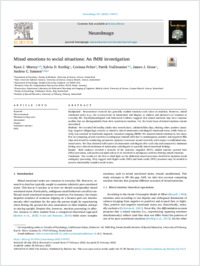Mixed emotions to social situations: An fMRI investigation
IPC
- Murray, Ryan j. Department of Psychiatry, Faculty of Medicine, University of Geneva, Geneva, Switzerland. Swiss Center for Affective Sciences, University of Geneva, Campus Biotech, Geneva, Switzerland
- Kreibig, Sylvia D. ORCID Department of Psychology, Stanford University, Stanford, CA 94305 USA
- Pehrs, Corinna Bernstein Center for Computational Neuroscience Berlin, BCCN, Berlin, Germany
- Vuilleumier, Patrik ORCID Swiss Center for Affective Sciences, University of Geneva, Campus Biotech, Geneva, Switzerland. Neuroscience Department, Laboratory for Behavioral Neurology and Imaging of Cognition, Medical school, University of Geneva, Campus Biotech, Geneva, Switzerland
- Gross, James J. Department of Psychology, Stanford University, Stanford, CA 94305 USA
- Samson, Andrea C. ORCID Swiss Center for Affective Sciences, University of Geneva, Campus Biotech, Geneva, Switzerland. Faculty of Psychology, UniDistance Suisse, Brig, Switzerland. Institute of Special Education, University of Fribourg, Fribourg, Switzerland
- 26.02.2023
Published in:
- NeuroImage. - Elsevier BV. - 2023, vol. 271, p. 119973
English
Background: Neuroscience research has generally studied emotions each taken in isolation. However, mixed
emotional states (e.g., the co-occurrence of amusement and disgust, or sadness and pleasure) are common in
everyday life. Psychophysiological and behavioral evidence suggests that mixed emotions may have response
profiles that are distinguishable from their constituent emotions. Yet, the brain bases of mixed emotions remain
unresolved.
Methods: We recruited 38 healthy adults who viewed short, validated film clips, eliciting either positive (amusing),
negative (disgusting), neutral, or mixed (a mix of amusement and disgust) emotional states, while brain activity
was assessed by functional magnetic resonance imaging (fMRI). We assessed mixed emotions in two ways:
first by comparing neural reactivity to ambiguous (mixed) with that to unambiguous (positive and negative) film
clips and second by conducting parametric analyses to measure neural reactivity with respect to individual emotional
states. We thus obtained self-reports of amusement and disgust after each clip and computed a minimum
feeling score (shared minimum of amusement and disgust) to quantify mixed emotional feelings.
Results: Both analyses revealed a network of the posterior cingulate (PCC), medial superior parietal lobe
(SPL)/precuneus, and parieto-occipital sulcus to be involved in ambiguous contexts eliciting mixed emotions.
Conclusion: Our results are the first to shed light on the dedicated neural processes involved in dynamic social
ambiguity processing. They suggest both higher-order (SPL) and lower-order (PCC) processes may be needed to
process emotionally complex social scenes.
emotional states (e.g., the co-occurrence of amusement and disgust, or sadness and pleasure) are common in
everyday life. Psychophysiological and behavioral evidence suggests that mixed emotions may have response
profiles that are distinguishable from their constituent emotions. Yet, the brain bases of mixed emotions remain
unresolved.
Methods: We recruited 38 healthy adults who viewed short, validated film clips, eliciting either positive (amusing),
negative (disgusting), neutral, or mixed (a mix of amusement and disgust) emotional states, while brain activity
was assessed by functional magnetic resonance imaging (fMRI). We assessed mixed emotions in two ways:
first by comparing neural reactivity to ambiguous (mixed) with that to unambiguous (positive and negative) film
clips and second by conducting parametric analyses to measure neural reactivity with respect to individual emotional
states. We thus obtained self-reports of amusement and disgust after each clip and computed a minimum
feeling score (shared minimum of amusement and disgust) to quantify mixed emotional feelings.
Results: Both analyses revealed a network of the posterior cingulate (PCC), medial superior parietal lobe
(SPL)/precuneus, and parieto-occipital sulcus to be involved in ambiguous contexts eliciting mixed emotions.
Conclusion: Our results are the first to shed light on the dedicated neural processes involved in dynamic social
ambiguity processing. They suggest both higher-order (SPL) and lower-order (PCC) processes may be needed to
process emotionally complex social scenes.
- Faculty
- Faculté des lettres et des sciences humaines
- Department
- Département de Pédagogie spécialisée
- Language
-
- English
- License
- Open access status
- gold
- Identifiers
-
- DOI 10.1016/j.neuroimage.2023.119973
- ISSN 1053-8119
- Persistent URL
- https://folia.unifr.ch/unifr/documents/324880
Statistics
Document views: 70
File downloads:
- murrayetal.2023.mixedemotionstosocialsituationsanfmriinvestigation_2: 276
